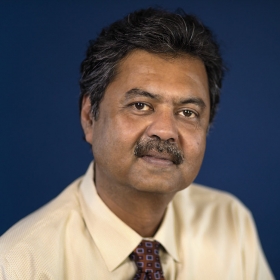Dave Chakraborty
The College is building a new Science Center, renovating residential halls that have significant needs, and looking at how to become carbon neutral by 2040. Meet the man with the plan, Dave Chakraborty, assistant vice president of facilities management and planning.

Photo by Lisa Abitbol
When Dave Chakraborty was interviewing for his job as assistant vice president of facilities management and planning at Wellesley in 2016, he was struck by the beauty of the campus and its historic buildings, and by how much everyone he spoke with loved the College. But he could also tell, even from his first strolls through the buildings, that an enormous amount of work needed to be done.
The College’s leadership knew that due to maintenance that had been deferred for decades, many of the buildings had very significant needs, Chakraborty says. They also knew the very substantial price tag, but the details and complex sequencing of the work ahead on many buildings still needed to be worked out. “What is the plan? How do you optimize the value? I thought it was an extremely challenging task to satisfy the different maintenance needs with the historic importance of certain buildings,” says Chakraborty, a civil engineer by training. “And so what absolutely intrigued me was, how do you put this puzzle together?”
Chakraborty and his team started by assessing 53 buildings on campus—about 2.5 million square feet total—and the infrastructure (electrical conduits, pipes, etc.) that supports them. To begin to address the residence halls, they met with then-interim dean of students Carol Bate and groups of students. He learned that many problems could be solved relatively easily—broken ceiling tiles, plumbing fixtures in need of repair, and much more. So they started a list to attack quickly. Those surface-level repairs alone cost $1 million.
At the same time, with help from new hires including Michael Lane, director of facilities operations, and Michelle Maheu, director of planning, design, and construction, his department created a five-year plan for renovating and updating the res halls—replacing carpeting and lighting, painting, renovating kitchenettes and common areas, upgrading elevators, and repairing leaking roofs. By summer 2019, year three, $16 million had been spent on work on Bates, Freeman, McAfee, Cazenove, Pomeroy, Munger, Stone-Davis, and Homestead. Next summer, Tower Court, Claflin, and Severance will undergo an $8 million renovation. These renovations will improve accessibility, another priority that Chakraborty’s team has studied extensively. The team has also developed a five-year plan for renovations of academic buildings and site infrastructure.
Chakraborty and his team are also investigating ways to make the campus more energy efficient and sustainable. He’s a member of E2040, the board of trustees working group chaired by trustee Laura Daignault Gates ’72, which is creating a long-term plan for the College to achieve carbon neutrality by 2040. This year, the group is working with an engineering consulting firm to look at renewable sources of energy for heating and cooling on campus.
The new construction in the Science Center, which began this fall, will have the infrastructure in place to support heating and cooling using energy from renewable sources. All existing buildings will have to have their heating and cooling systems entirely replaced in order to use the technology. “It’s a huge endeavor for the College to undertake. The change is not going to happen overnight, but will require careful planning and scheduling to implement the conversion over a long period of time,” says Chakraborty.
In the meantime, the College is investing in many different energy-conservation measures. Over the next two years, Chakraborty’s team will take on $6 million worth of energy-conservation projects in all the buildings on campus—installing LED lighting and control systems so it’s easier to regulate how much heat or cooling goes into a building, for example. And when these energy-conservation measures are done, they’ll also make renovations and improve accessibility.
“My favorite part of my job, hands down, is when I can stretch the value of the dollar, figure out the synergies between various areas, and when I know that I’ve been able to propose or deliver a project that provides the best value to the College,” Chakraborty says. “That is my favorite day, if I can figure that out.”


